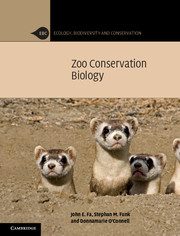Book contents
- Frontmatter
- Contents
- Foreword
- Preface
- Acknowledgements
- 1 Biodiversity and zoo conservation biology
- 2 Protecting species and habitats
- 3 Zoos in focus – public exhibition or conservation
- 4 Keeping animals in captivity
- 5 Viable captive populations – the numbers game
- 6 Captive breeding and zoos
- 7 Returning animals to the wild
- 8 Educating the public
- 9 Turning zoos into conservation centres
- Appendix 1 Commonly used abbreviations
- Appendix 2 Scientific names of species mentioned in the text
- Appendix 3 Inbreeding
- Appendix 4 Population sizes – definitions and implications
- Appendix 5 Captive breeding and genetics – definitions
- References
- Index
- Plate section
2 - Protecting species and habitats
Published online by Cambridge University Press: 05 August 2012
- Frontmatter
- Contents
- Foreword
- Preface
- Acknowledgements
- 1 Biodiversity and zoo conservation biology
- 2 Protecting species and habitats
- 3 Zoos in focus – public exhibition or conservation
- 4 Keeping animals in captivity
- 5 Viable captive populations – the numbers game
- 6 Captive breeding and zoos
- 7 Returning animals to the wild
- 8 Educating the public
- 9 Turning zoos into conservation centres
- Appendix 1 Commonly used abbreviations
- Appendix 2 Scientific names of species mentioned in the text
- Appendix 3 Inbreeding
- Appendix 4 Population sizes – definitions and implications
- Appendix 5 Captive breeding and genetics – definitions
- References
- Index
- Plate section
Summary
‘The beauty and genius of a work of art may be reconceived…but when the last individual of a race of living things breathes no more, another heaven and another earth must pass before such a one can be again’
(William Beebe)Introduction
The roots of the modern environmental movement can be traced to nineteenth-century Europe and North America in which a mix of passion, power, calculation and even remorse motivated elites to safeguard wildlife. It was through the emergence of the ‘penitent butcher’ (Beinart & Coates, 1995), epitomised by the ‘repentance’ of prominent hunters, themselves the cause of much megafauna to plummet (tigers, lions, elephants and rhinos in Africa and Asia, bison, moose and bear in North America), that the need for species conservation, albeit only of large-bodied species, emerged (Adams, 2004; MacKenzie, 1988). The result was the creation of influential NGOs such as the Sierra Club in the USA in 1892 (Carter, 2007), or the UK's Society for the Preservation of the Fauna of the Empire (now Fauna and Flora International) in 1903 (Fitter & Scott, 1978).
- Type
- Chapter
- Information
- Zoo Conservation Biology , pp. 29 - 52Publisher: Cambridge University PressPrint publication year: 2011

